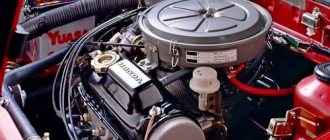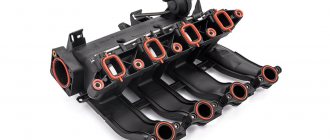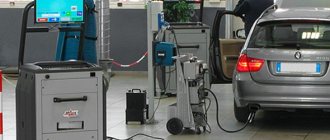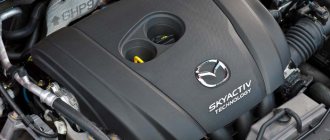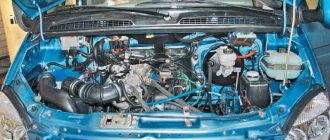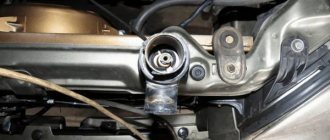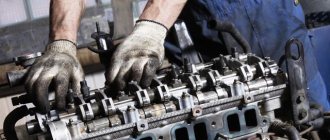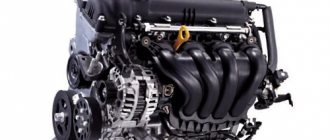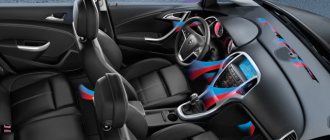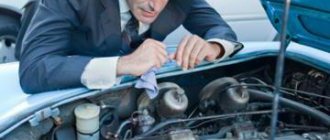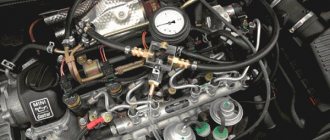Engine power system repair
The main malfunctions of the power system of a gasoline engine with a carburetor are:
- stopping the fuel supply to the carburetor;
- formation of a too lean or rich combustible mixture;
- fuel leakage, difficulty starting a hot or cold engine;
- unstable engine operation at idle;
- interruptions in engine operation, increased fuel consumption;
- increased toxicity of exhaust gases in all operating modes.
The main reasons for stopping the fuel supply may be : damage to the valves or diaphragm of the fuel pump; clogged filters; freezing of water in fuel lines.
In order to determine the reasons for the lack of fuel supply, you need to disconnect the hose supplying fuel from the pump to the carburetor, lower the end of the hose removed from the carburetor into a transparent container so that gasoline does not get on the engine and prevent it from catching fire, and pump up the fuel using the manual pump lever of the fuel pump or turning the crankshaft with the starter. If a stream of fuel appears with good pressure, then the pump is working.
Then you need to remove the fuel filter from the inlet fitting and check whether it is clogged. A pump malfunction is indicated by poor fuel supply, intermittent fuel supply and no fuel supply. These reasons may also indicate that the fuel supply line from the fuel tank to the fuel pump is clogged.
The main reasons for a lean combustible mixture may be : a decrease in the fuel level in the float chamber; sticking of the needle valve of the float chamber; low fuel pump pressure; contamination of fuel jets.
If the throughput of the main fuel jets changes, this leads to an increase in the toxicity of exhaust gases and a decrease in the economic performance of the engine.
If the engine loses power, “shots” are heard from the carburetor, and the engine overheats, then the causes of these problems may be: poor fuel supply to the float chamber, clogged nozzles and nozzles; clogging or damage to the economizer valve, air leaks through leaks in the carburetor and intake manifold.
Loss of engine power when running on a lean mixture may occur due to slow combustion of the mixture and, as a result, lower gas pressure in the cylinder. When the combustible mixture becomes lean, the engine overheats because combustion of the mixture occurs slowly and not only in the combustion chamber, but throughout the entire volume of the cylinder.
In this case, the heating area of the walls increases and the coolant temperature rises.
To repair and eliminate defects, it is necessary to check the fuel supply. If the fuel supply is normal, you need to check whether there is any air leakage in the connections, for which you start the engine, close the air damper, turn off the ignition and inspect the junction of the carburetor and the intake pipe. If wet spots of fuel appear, this indicates the presence of leaks in these places. Eliminate defects by tightening the nuts and bolts. If there is no air leakage, check the fuel level in the float chamber and, if necessary, adjust it.
If the jets are clogged, they are blown out with compressed air or, as a last resort, carefully cleaned with soft copper wire.
Fuel leaks should be repaired immediately due to the possibility of a fire and excessive fuel consumption. It is necessary to check the tightness of the fuel tank drain plug, the connections of the fuel lines, the integrity of the fuel lines, the tightness of the diaphragms and connections of the fuel pump.
The reasons for difficulty starting a cold engine can be: lack of fuel supply to the carburetor; malfunction of the carburetor starter; ignition system problems.
If fuel is supplied well to the carburetor and the ignition system is working properly, a possible reason may be a violation of the adjustment of the position of the air and throttle valves of the primary chamber, as well as the pneumatic corrector of the starting device. It is necessary to adjust the position of the air damper by adjusting its cable drive and check the operation of the pneumatic corrector.
Unstable engine operation or stopping of its operation at low idle speed can be caused by the following reasons: incorrect ignition installation; the formation of carbon deposits on the spark plug electrodes or an increase in the gap between them; violation of the adjustment of the gaps between the rocker arms and the camshaft cams; decreased compression; air leakage through the gaskets between the head and the intake pipe and between the exhaust pipe and the carburetor.
Natural wear and tear of the motor as a cause of failure
Diesel cars are real workhorses that their owners operate under the most severe conditions. It is not uncommon when buying a used car from Europe that their mileage is around 500 thousand kilometers or more.
It is not surprising that such engines with enormous mileage break down due to their natural wear and tear. Numerous diesel engine malfunctions appear and their elimination can be somewhat difficult.
The engine may have difficulty starting, loses some of its power, and oil regularly leaks from under the gaskets and individual attachments. Quite often there are minor breakdowns that annoy the car owner. All these are signs of a worn-out engine that requires major repairs.
However, even such an expensive overhaul often cannot correct the problem. In this case, we can recommend an engine swap or the purchase of a new, more recent car.
Diesel engines of cars are characterized by high reliability; however, the possibility of failure of any components or systems for various reasons during operation cannot be ruled out. You should adhere to the rules that are regulated by the documentation of the manufacturer, otherwise, due to frequent breakdowns and improper repairs, the service life of the diesel engine is sharply reduced.
Malfunctions:
- difficult starting of a cold and hot engine;
- idle failures;
- reduction in engine power;
- fuel and oil consumption have increased;
- noises and knocking appeared in the diesel engine;
- the engine does not hold speed well;
- Blue or black exhaust occurs periodically.
Diesel problems can arise for a number of reasons. For example, due to unqualified maintenance and improper use. We must remember that it is better to carry out diagnostics, repairs of diesel engines, as well as adjustment of their components and mechanisms in a trusted service center, where experienced technicians will provide competent maintenance of your car’s engine both during the warranty and post-warranty periods. They will also provide you with all the necessary information.
It is recommended to change the oil no more than after 7-7.5 thousand km. mileage This is primarily due to Russian realities: domestic diesel fuel contains many impurities, including sulfur, as a result of which the oil tends to oxidize. The quality of the oils used must also meet the standards stated by the manufacturer.
The quality of diesel fuel greatly affects the service life of the engine. According to statistics, half of all engine malfunctions in general and the fuel system in particular are directly dependent on fuel. Imported fuel is “cleaner” than Russian fuel and contains less various mechanical impurities and water. However, refueling with foreign fuel will cost significantly more.
Various types of problems can appear after poorly carried out repairs of a diesel power unit, because in order to correctly eliminate all problems, mechanics are required to have knowledge of all the design features of the engine. Only high-quality original spare parts should be installed and components should be replaced in a timely manner. All this will extend the operation of the engine, as well as save money.
The main signs of malfunctions include: difficulty starting the engine. Typically the culprit is poor compression. For the same reason, the engine begins to operate intermittently, the fuel is poorly atomized, and noise occurs.
Natural wear and tear of the engine can be caused by high mileage of the car, after which defects in the fuel equipment components are noted. Compression decreases and the piston group wears out. In cold weather, it becomes increasingly difficult to start the engine. Signs of natural wear of the diesel engine are indicated by an increase in oil consumption, as well as crankcase gas pressure.
If the injector nozzles wear out, black smoke appears from the exhaust pipe and fuel consumption increases. The normal lifespan for a sprayer is from 60 to 80 thousand km. Long-term operation of the motor with this type of malfunction will ultimately lead to burnout of the prechambers.
Quite often, the plunger pairs of diesel injection pumps wear out. A sign of their defects is poor starting of a heated engine.
Today, many motorists have cars that use diesel fuel as fuel. Many owners of such cars will be interested to know about what types of diesel engine malfunctions there are and how to fix them. It seems to us that this article will be especially interesting to car owners who, after using gasoline modifications of their cars for a long time, switched to diesel cars. This is due to the large difference in maintenance and operation of such models. To enjoy owning such a car, you need to know as much as possible about it.
Diesel engine malfunctions and their elimination, knowledge of these features, the ability to find and fix problems that arise will be useful for all drivers. Imagine this situation. A trip outside of urban areas in a jeep, and most of these vehicles have diesel power units, was interrupted due to its breakdown. “Civilization” is dozens of kilometers away, there is no one to expect help from, and no one knows what to do. Let's try to talk in simple words about possible breakdowns of such machines.
Carburetor engine diagnostics: power system
Even taking into account the fact that cars equipped with a carburetor are an outdated solution, such cars continue to be popular in the CIS and are firmly established in the lower price segment. At the same time, the relatively simple power system of a carburetor engine requires special attention and needs regular maintenance.
This approach makes it possible to achieve stable operation of the internal combustion engine in different modes, as well as reduce fuel consumption and exhaust toxicity levels. Next, we will look at the main malfunctions of the power supply system of engines with a carburetor, which usually arise during vehicle operation.
Engine power system with carburetor: features and problems
As you know, a car internal combustion engine, regardless of the type of engine and type of fuel (carburetor, injection, gasoline or diesel), runs on a mixture of fuel and air.
Air is “sucked in” by the engine from the atmosphere, and fuel is supplied from the fuel tank through the fuel lines due to the operation of the fuel pump (mechanical or electric). The so-called fuel-air working mixture consists of fuel and air, which are mixed in strictly defined proportions. Then the working mixture is burned in the cylinders.
On certain engines, fuel supply and mixture formation can also be implemented in different ways. In injection engines (except engines with direct injection), fuel is first supplied to the intake manifold through injectors, after which it is mixed with the air there. The mixture then enters the combustion chamber.
In a diesel engine, fuel is injected directly into the combustion chamber, where pre-supplied, compressed and heated air is already located. By the way, a diesel engine has the most complex fuel system.
For this reason, diagnosing the power supply system of a diesel engine is an important and responsible procedure, since the overall service life of such engines greatly depends on the proper operation of the diesel power system.
- If we talk about a carburetor, this is the simplest mechanical metering device; a carburetor engine has external mixture formation. This means that a ready-made working mixture of fuel and air enters the cylinders. The preparation of the air-fuel mixture occurs in the carburetor, where both fuel and air are supplied.
As a rule, carburetors are mechanical devices, that is, the design does not involve the active use of electronic components. The only exceptions can be considered only certain later developments, which are actually transitional devices from a carburetor to a monoinjector. Such carburetors contain separate electronic actuators.
Fuel supply problems
It is also not uncommon to have problems with injectors and injection, which leads to the need for major expensive repairs. Such malfunctions are caused by the use of low-quality Russian diesel fuel.
Modern high-tech diesel engines show excellent fuel and economic performance. However, all of them are designed with increased requirements for the quality of diesel fuel, which must contain a minimum of sulfur and other impurities. In Russia, the quality of diesel fuel is far from ideal. As a result, engines quickly fail and require expensive repairs.
For example, low-quality diesel fuel leads to the failure of injectors, which are replaced as a whole set and have a fairly high cost. With such breakdowns, the car owner may notice problems with the car's traction, which is significantly reduced, and uncharacteristic tremors and vibrations of the engine appear in various speed ranges.
These are all symptoms of fuel injector problems.
But on a modern engine, replacing them is somewhat difficult, and the cost of such spare parts is high.
Repair
If it does happen that the high-pressure fuel pump breaks down, you need to immediately repair the injection pump. You can do this yourself or by taking the car to a service station.
If, nevertheless, it was decided that the fuel injection pump repair would be done with your own hands, then the first thing you need to do is remove this device from the car. In fact, this is mandatory not only during the repair of this particular part, but also during the repair of any other vehicle device.
- After the injection pump has been removed, it needs to be washed. Having done this, you can ensure yourself a clean workplace, but if there is no time for cleaning, then you can start disassembling from the very beginning.
- Please note that the necessary set of tools, which includes a set of wrenches, hexagons, screwdrivers, a clean rag, tweezers, a container, a gas wrench and a vice, must be prepared in advance, because you often have to look for all the tools while working.
- So, by removing the top cover of the fuel pump housing, we see the entire mechanism. You can get it out only by moving the drive back until the phases are aligned, and only then can you lift the drive up.
As a rule, there is no need to disassemble the drive itself, because it is rarely possible to put it back together.
- After this, you need to unscrew three nuts, one of which is not so easy to get out. There are two ways to solve this problem. The first way is to unscrew the first two and then with difficulty unscrew the third, and the second option is to disassemble the drive. Of course, the second option is possible, but it will significantly complicate the process. On the body of each pump there is a special plate from which you can find out all its characteristics.
Please note that the manufacturer of the pump may differ from the manufacturer of the entire machine. This primarily indicates that it has already been replaced by an analogue, and the standard one was thrown out long ago. In this case, you can replace this injection pump with a new one, but a new pump is very expensive, so not every driver can afford it.
- Next you need to start completely disassembling the entire pump. During disassembly, you should put the parts in the order in which they were removed, so that after repair it will be possible to put everything back together so that it all works. Some components and assemblies will require special keys, so if they are not available, then you can leave those devices in place if there is no doubt about their functionality.
- After complete disassembly, you need to look for faulty parts, and if any are found, then you need to go to a car store and buy new spare parts.
After installing new parts, the device should be fully operational. You can carry out such repairs only taking into account the fact that you have at least minimal knowledge in the plumbing field, namely knowledge of how the bolts are unscrewed and how to tighten them back. Of course, after such manipulations, it is better to take the equipment to a stand, where an experienced specialist will fine-tune the injection timing and pressure.
Heavy exhaust smoke
The appearance of black smoke from the exhaust pipe indicates an overload of the power unit. Changing to a lower gear will clear the exhaust. This phenomenon may also be caused by a lack of air due to a dirty air filter. Flushing a car's air cleaner cleans up the exhaust.
White smoke may appear when the engine is not warmed up or after water gets into the diesel fuel. Blue smoke can serve as a signal to the driver that the oil level in the pan is too high. Bringing it to normal eliminates the appearance of smoke. Signs of piston wear are also determined by the appearance of blue smoke. You should also check the reliability of the connections in the pipelines and do not forget to drain the sediment from the fuel tank.
Unexpected engine stop
. The culprit for this problem may be a lack of fuel in the power system. If it is present in the tanks, you should check the cleanliness of the fuel filters. Washing the filters or installing new filter elements will relieve the driver of such a malfunction.
Check the cleanliness of the hole in the gas tank cap; it serves to connect its cavity to the atmosphere. If there is no air in the tank, the fuel pump is unable to provide the engine with the required amount of fuel.
